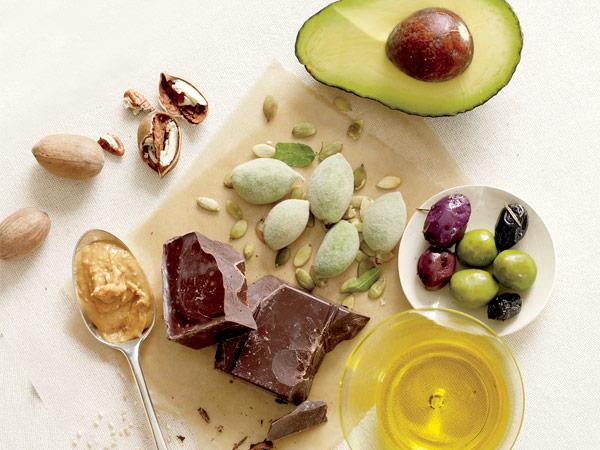The Skinny on Fats

June 19, 2014
When the word fat is uttered, a million 16 year old girls on a “no carb-no sugar-no calorie-lets not eat anything” diet gasp with ignorant horror- and it isn’t their fault. Our culture has given the term fat a narrow definition that comes with a hefty amount of negative connotations. We forget to recognize that fats are a “wide group of compounds”, emphasis on wide. That is why it has come to my attention that someone has to explain that sometimes fat isn’t actually going to make you fat. What if I told you there were good fats? Well hello, this is me telling you there are good fats. Get ready for the skinny on fats and find out what you’re missing.
DISCLAIMER: This might be the most simplified scientific explanation ever. Let me break it down for you: We can separate dietary fats into saturated fats, trans fats (bad), and monounsaturated fats, polyunsaturated fats, and omega-3 fatty acids (good). Saturated and trans fats are what people commonly associate all fats with. They are the fats found in food such as red meat, poultry, full-fat dairy products, butter, shortening and stick margarine. We need to distinguish the good from the bad and recognize that you won’t find bacon grease in avocados.
The silver lining when it comes to dietary fats are the ones that improve heart health, control blood sugar levels, regulate blood pressure, and decrease the risk of coronary artery disease. I’m talking about the magic trio. The three musketeers. The holy grail of beneficial fats. They are polyunsaturated fats, monounsaturated fats, and omega-3 fatty acids Here is a list of foods rich in healthy fats that not only have endless benefits but are necessary to a balanced diet.
1. Avocados– Known as the “butter pear” for its creamy consistency, this summer staple veggie is delicious in salads, guacamole, or even halved with salt and pepper. Unfortunately, avocados can be given a bad rap for their calories being made up of 85% fat. However, the fat found in avocados can be separated into three categories– phytosterols, polyhydroxylated fatty alcohols, and oleic acid. These three fats come together and act as a powerful anti inflammatory agent that also have the ability regulate your digestive tract. Before saying no to this fat rich food, get familiar with the specific fat composition because the uniqueness of the three-fold fat produces a bounty of ironic health benefits.
2. Nuts– I could write novels on nuts. I could literally write books on why they are so spectacular and why they are so underrated and even why they are the shape that they are. The two that have shown the most benefit when it comes to their fat content are walnuts and almonds. Walnuts are very rich in the plant-based omega-3 fatty acid ALA which decreases inflammation that can damage arteries and may help reduce the breakdown of bone. Almonds on the other hand, have enough fiber in them to counteract and stop some of the nut fat from being digested and absorbed without completely losing the good fats effects. Another benefit is feeling satisfied after snacking on nuts and therefore naturally compensating for the calories in the nuts by eating less during the day.
3. Fatty Fish— Fish such as salmon, sardines, smelt, shad, and achovies are some of the world most richest foods in omega-3’s. The oily fish are packed with good fat and help to lower cholesterol, triglycerides, and blood pressure, and also prevent blood clots, reduce inflammation, and balance the immune system. However, take caution when you decide to add more of the self proclaimed “brain food” to your diet. Make sure you know whether the fish is farm raised or wild caught.Due to their compact living situations and feed, farm raised fish tend to have more diseases, toxins, artificial dyes, antibiotics and contain an unnecessary surplus amount of fat then compared to their wild caught versions.
4. Olive/Canola Oil– Before you sautee those veggies with melted butter think about it. Do you really need to add saturated fats to your healthy meal? No. Using butter to cook with is not only foolish but can be easily substituted with oils made of monounsaturated fats such as olive and canola oil. The high monounsaturated fatty acid content of olive oil is extremely cardioprotective — it cuts your ‘bad’ cholesterol level, helps prevent atherosclerosis, and can bump up your level of HDL, the ‘good’ cholesterol. When olive oil does not fit into a recipe, use canola oil. Canola oil has a bland taste and unlike olive oil it will not overpower any recipe. Both oils work as a great base for salad dressings and try my favorite– drizzle a little olive oil over popcorn (instead of butter) and sprinkle some salt on top.
5. Dark Chocolate— Whether it be the result of a breakup, a gift on valentines day, or a simple token of self appreciation and a whole lot of “I deserve this,” everyone has experienced the chocolate experience. Chocolate has made a name for itself as a comforting candy commodity and usually is pegged with negative connotations and given the same bad rap as other candies that are high in sugar. However if you chose the right kind of chocolate, the benefits may outweigh the risk. Dark chocolate contains 4.5 grams of monounsaturated fat and .0.4 grams of polyunsaturated fat (most of which is omega-6 fatty acids). As an antioxidant, dark chocolate lowers the risk of heart disease and also contains cocoa phenols which lower blood pressure. When it comes to deserts instead of a rich cake and ice cream, crush up two squares of dark chocolate and sprinkle on some vanilla yogurt.

